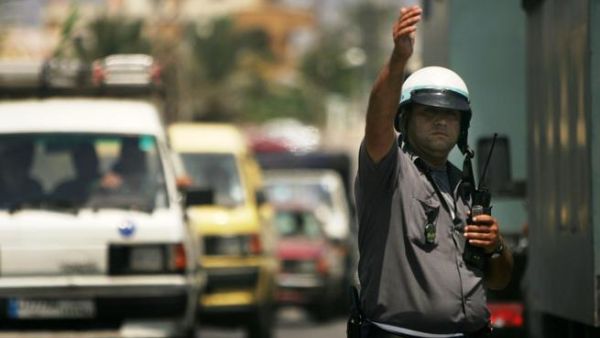The taxicab is one of those little knots that tie us together. There are still a few quaint pre-industrial holdouts – horse- or man-drawn carriages targeting gormless tourists and characters in romantic comedies – but the motorized cabs are the mainstay of urban traffic the world over.
The stories about taxis and the folks that drive them are at once universal and local, so Lebanese documentarian Hady Zaccak has struck gold with “Taxi Beirut.” Zaccak’s eighth feature-length doc (all running around an hour) premiered at the Beirut International Film Festival this week. Based on the reception of his full-house audience, he’s found a topic that touches local sentiment.
“Taxi Beirut” focuses upon three generations of Beirut cab drivers, all quite unlike one another apart from their chosen profession.
The film opens with Zaccak’s camera scrutinizing a cabbie from the passenger seat while he inches his car though one of the city’s infamous traffic jams. When the driver dings the car in front of him, he climbs out, exchanges a few words with the other driver, then makes an escape.
This is Amal Srour, the youngest of Zaccak’s three subjects, who returned to Beirut after some years working in Dubai and entered the taxi trade in 2006.
Depicted as a comic figure, Srour exhibits a bird-like hyperactivity whenever a customer climbs into his car. At once aggressive in peddling his services – he also hawks mobile telephone lines to passengers from out of town – he frankly tells his customers that the more he’s paid, the more he’ll do for them.
At one point the camera listens in while Srour flogs the advantages of his late model Taurus – “It has seven seats,” he points out. “That means it’s cheaper to ride with me than other taxis.”
A cab-driver since 1998, Fadi Khairallah is a middle-aged veteran of Lebanon’s Civil War, having fought for one of the country’s Christian militias. He’s also enough of a celebrity to warrant a mention in the stand-up comedy routine of a well-known Beirut performer.
The most-earthy of the three characters, Khairallah has the most colorful vocabulary of the three men – Zaccak makes a comic virtue of this by rendering some of his more esoteric blasphemies as ellipses in his subtitles – and has a jocular physical abusiveness with his pals.
“Beirut isn’t chaos!” Khairallah says while navigating a Beirut traffic jam. “It’s to the point that anyone buying a newspaper will get a ticket for it.”
The taxi-driving veteran is Fouad al-Chami. He says he’s been driving a cab since 1957 and reminisces that he travelled to Germany to buy his first Mercedes in 1961.
Though he’s as capable of ripe humor as Khairallah, the fedora and blazer-clad Chami is the more-sorrowful of the three figures. At one point he gasps that driving in Beirut traffic exhausts him.
Over the last decade or so, the 37-year-old Zaccak has proved himself one of Lebanon’s most sturdy hands when it comes to television documentary. Unlike certain “creative documentary” practices – which employ more-subjective, self-consciously artistic film techniques – television documentaries generally retain the classical premise of looking outward at the world, while avoiding the god-like pose of some of the earliest documentaries.
Since the events of 2005 and the troubles that spun out of them, Zaccak has taken his camera to such wide-angle topics as “Lebanon’s Shia” and the country’s Palestinian refugees.
His most successful works have been those that have erred toward individual voices rather than apparently grand generalizations about great swathes of Lebanese society. Arguably his best work is the 2009 doc “A Lesson in History,” in which he visits various schools around Lebanon and speaks to the students about their knowledge of their national history.
The power of that film resides in the relatively narrow compass of its subject, which gives it more room to breathe with implications, and in the comedy of its characters – which tends to shade quietly into tragedy.
“Taxi Beirut” is from the same mould as “A Lesson in History.” The drivers’ monologues, most set within the chaos of Beirut traffic, are linked by motifs of urban construction and road works. The camera of DOP Muriel Aboulrouss also falls lovingly upon the several generations of automobiles that (in various states of repair) stalk Beirut’s streets.
The drivers’ predicaments are placed in the context of changes in the city generally and a segue toward the destruction of the city’s architectural patrimony is capped by one of the drivers observing that, “It’s true that Beirut has become more beautiful recently, but it’s also become expensive for us.”
Though “Taxi Beirut” is ostensibly about taxi drivers, then, it really samples the rapidly changing face of the city whose streets these men navigate.
There’s plenty of comedy in the film that will especially amuse anyone who understands a bit of Lebanese Arabic. All three men talk about their cars in the most intimate and affectionate terms – all refer to his machine this as she/her.
The most sustained comic interlude comes near the end of the work, when the film metronomes between Srour and Khairallah as they both chat up their respective passengers – the former in English and Arabic, the latter in French.
The fact that Chami is excluded from this two-way dialogue between the former fighter and the entrepreneur underlines the quiet sadness of this otherwise amusing film.
By Jim Quilty








